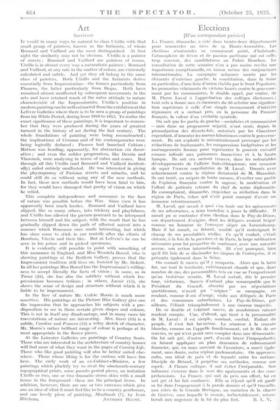Art
Survivors IT would in many ways be natural to class Utrillo with that saran group of painters, known as the Intimists, of whom 'Bonnard and Vuillard are the most distinguished. At first Sight the similarity may not be obvious. Utrillo is a painter of streets ; Bonnard and Vuillard are painters of rooms. ttrillo is in almost every way a naturalistic painter ; Bonnard and Vuillard, at any rate in the matter of colour, arc extremely calculated and subtle. And yet they all belong to the same class of painters. Both Utrillo and the Intimists derive .essentially from Impressionism—the former particularly from Pissarro, the latter particularly from Degas. Both have remained almost unaffected by subsequent movements in the arts and have retained much of the naive attitude to nature characteristic of the Impressionists. Utrillo's position in modern painting can be well estimated from the exhibition at the Lefevre Galleries where there is to be seen a group of paintings from his White Period, dating from 1910 to 1915. To realise the exact significance of these paintings, it is important to remem- ber that they were produced during the years of greatest turmoil in the history of art during the last century. The whole foundations of painting were being reconstructed ; the implications of Cezanne and of his contemporaries were being logically deduced ; Picasso had launched Cubism ; Matisse was heading, apparently, for abstraction via decor- ation ; and even the milder progressives, like Derain and Vlaminck, were analysing in terms of cubes and cones. But through all this Utrillo (and Bonnard and Vuillard incident- ally) sailed entirely unaffected. He was interested in giving the physiognomy of Parisian streets and suburbs, and he could still do so without using any of the new methods. In fact, these new methods would have been fatal to him, for they would have damaged that purity of vision on which he relied.
This complete independence and assurance in the face of nature was possible before the War. Since then it has apparently been much harder. Bonnard and Vuillard have slipped, like so many others, into trickery and playfulness, and Utrillo has allowed the picture-postcard to be interposed . between himself and his subject, with the result that he has gradually slipped down the path of affected naivete into a manner which Rousseau once made interesting, but which has since come to stink in our nostrils after the efforts of Bombois, Vinvin and their like. But at Lefevre's he can be seen in his prime and in picked specimens.
It is evidently still possible to paint with something of this assurance in England, and Miss Wendela Bored, who is showing paintings at the Redfern Gallery, proves that the Impressionist tradition still lives on, fostered by Mr. Sickert. In all her paintings Miss Boreel has the Impressionist's willing- ness to accept literally the facts of vision ; in some, as in Torno (22), she has also the subtlety without which Im- pressionism becomes tedious ; in others, Lavoir (15), she shows the sense of design and structure without which it is liable to be impermanent.
In the face of nature Mr. Cedric Morris is much more assertive. His paintings at the Picture Hire Gallery give one the impression that he approaches his subjects with a pre- disposition to see in them certain given shapes and colours. This is not in itself any disadvantage, and in' many cases his travestations of nature are interesting. Mrs. Gorer (18) is a subtle, Caroline and Frances (15) a witty sketch of character. Mr. Morris's rather brilliant range of colour is perhaps at its most appropriate in the flower pieces.
At the Leicester Galleries are paintings of Country Seats. Those who are interested in the architecture of country houses will find more of what they want in the pages of Country Life. Those who like good painting will also be better suited else- where. Those whose liking is for the curious will have fun here. The early work of an ex-Cabinet •Minister, a few paintings which pluckily try to rival the nineteenth-century topographical prints, some pseudo period pieces, an imitation Utrillo or two, one or two dramatic storm skies with a small house in the foreground—these are the principal items. In addition, however, there are one or two canvases which give one an idea of what it must feel like to be a country gentleman, and one lovely piece of painting, Moatlands (7), by Ivon


























































 Previous page
Previous page